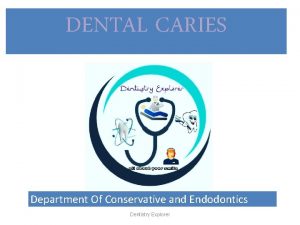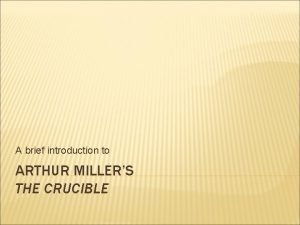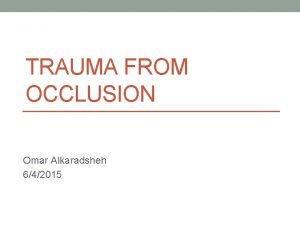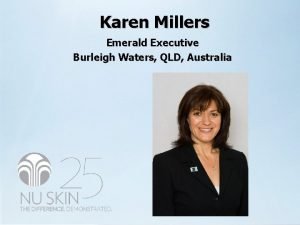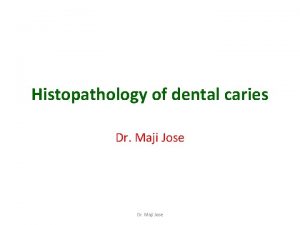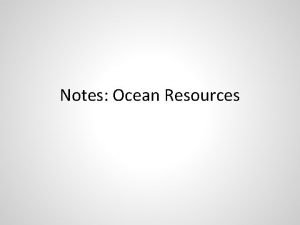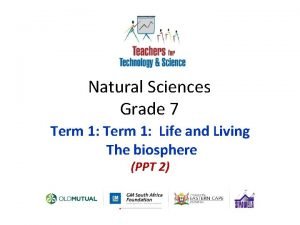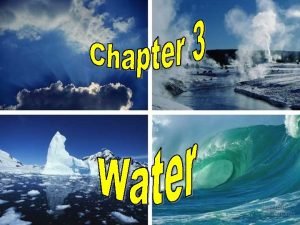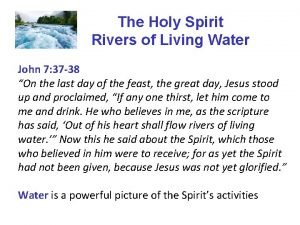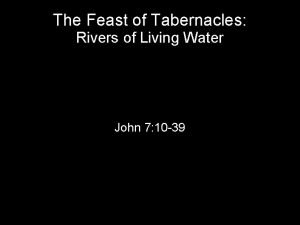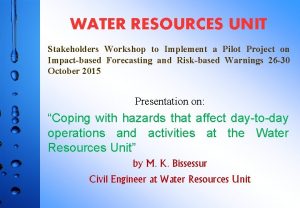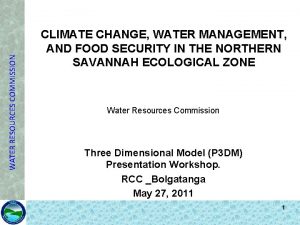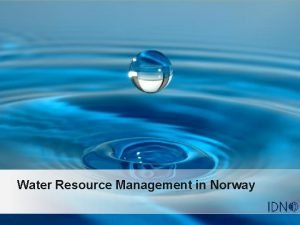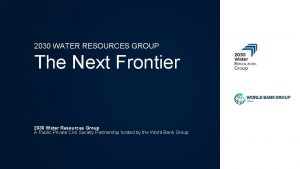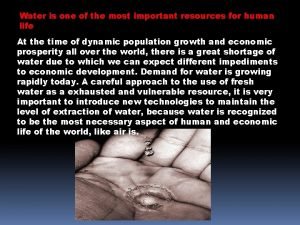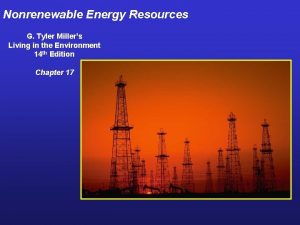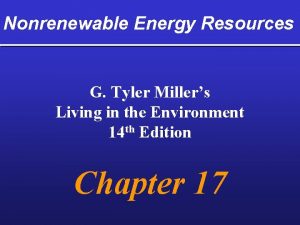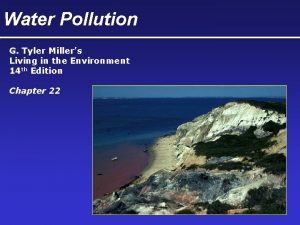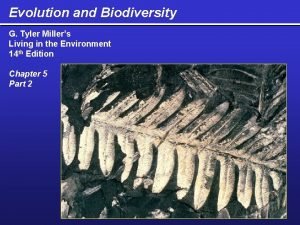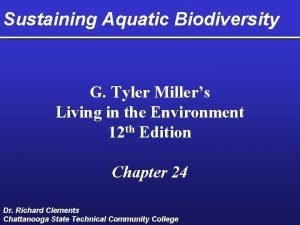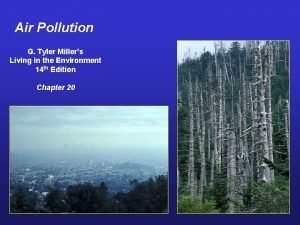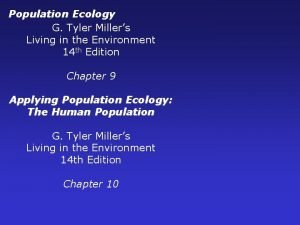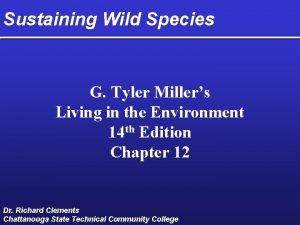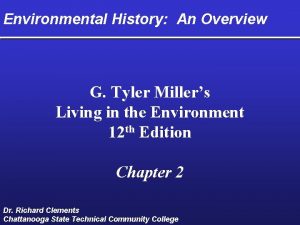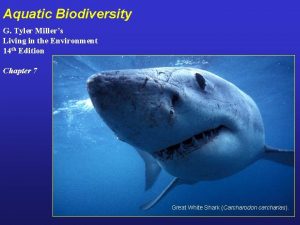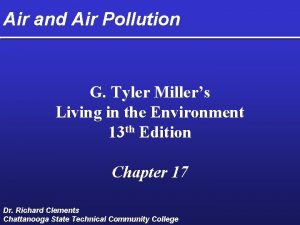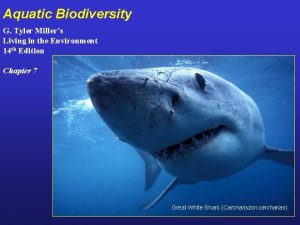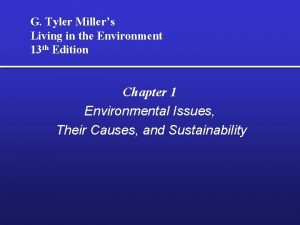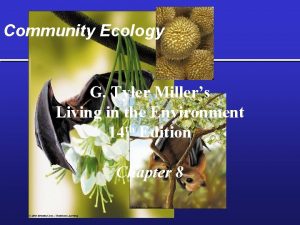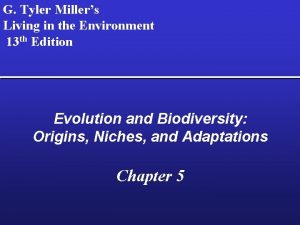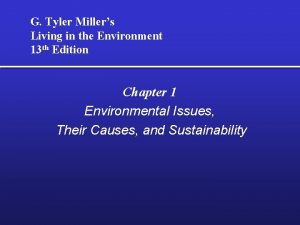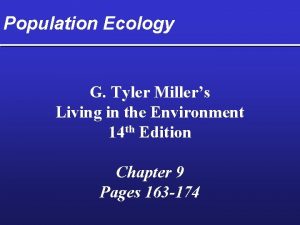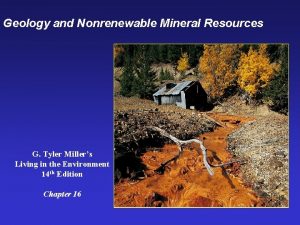Water Resources G Tyler Millers Living in the
































- Slides: 32

Water Resources G. Tyler Miller’s Living in the Environment 13 th Edition Chapter 14 Dr. Richard Clements Chattanooga State Technical Community College

Water’s Unique Properties Ø Hydrogen bonding Ø Liquid over wide temperature range Ø Changes temperature slowly Ø High heat of evaporation Ø Great dissolving power Ø p. H Ø Adhesion and cohesion Ø Expands when it freezes

Supply of Water Resources Freshwater Readily accessible freshwater Groundwater 0. 592% Biota 0. 0001% Lakes 0. 0007% Ice caps and glaciers 0. 592% 0. 014% Fig. 14 -2 p. 314 Soil moisture 0. 0005% Rivers 0. 0001% Atmospheric water vapor 0. 0001%

Surface Water Ø Surface runoff Ø Reliable runoff Ø Watershed Ø Drainage basin

Ground Water Fig. 14 -3 p. 315 Flowing artesian well Precipitation Well requiring a pump Evaporation and transpiration Evaporation Confined Recharge Area Runoff Aquifer Infiltration Stream Water table Infiltration Lake Unconfined aquifer Less permeable material such as clay Confined aquifer Confirming permeable rock layer

Use of Water Resources Ø Humans use about 50% of reliable runoff United States Ø Agriculture Ø Industry Power cooling 38% Ø Domestic Agriculture 38% Ø Power plants Fig. 14 -5 p. 316 Industry 11% Public 10%

Too Little Water Ø Dry climate Ø Drought Ø Dessication Acute shortage Ø Water stress Fig. 14 -7 p. 317 Adequate supply Shortage Metropolitan regions with population greater than 1 million

Using Dams and Reservoirs to Supply More Water Large losses of water through evaporation Flooded land destroys forests or cropland displaces people Downstream cropland estuaries are deprived of nutrient-rich silt Downstream flooding is reduced Reservoir is useful for recreation and fishing Can produce cheap electricity (hydropower) Fig. 14 -9 p. 319 Migration and spawning of some fish are disrupted Provides water for year-round irrigation of cropland

Transferring Water from One Place to Another Ø Watershed transfer CALIFORNIA Sacramento River Ø California Water Project North Bay Aqueduct UTAH Sacramento San Francisco South Bay Aqueduct Ø Central Arizona Project California Aqueduct Ø James Bay NEVADA Shasta Lake Fresno Los Angeles Aqueduct Los Angeles Colorado River ARIZONA Central Arizona Project Phoenix San Diego Colorado River Aqueduct Tucson MEXICO Fig. 14 -13 p. 323

Tapping Groundwater Ø Year-round use Ø No evaporation losses Ø Often less expensive Ø Potential Problems!

Problems with Using Groundwater Ø Water table lowering (See Fig. 14 -15 p. 326) Ø Depletion (See Fig. 14 -16 p. 326) Ø Subsidence (See Fig. 14 -16 p. 326) Ø Saltwater intrusion (See Fig. 14 -17 p. 328) Ø Chemical contamination Ø Reduced stream flows See Case Study p. 327

Converting Salt Water to Fresh Water and Making it Rain Ø Distillation desalination Ø Reverse osmosis desalination Ø Desalination is very expensive Ø Cloud seeding

Using Water More Efficiently Ø Reduce losses due to leakage Ø Reform water laws Ø Improve irrigation efficiency (Fig. 14 -18 p. 330) Ø Improving manufacturing processes Ø Water efficient landscaping Ø Water efficient appliances

Too Much Water: Floods Ø Natural phenomena Ø Aggravated by human activities Ø Renew and replenish Reservoir Dam Levee Flood wall Floodplain Fig. 14 -22 p. 332

Solutions: Achieving a More Sustainable Water Future Ø Efficient irrigation Ø Water-saving technologies Ø Improving water management See Fig. 14 -25 p. 336

Water Pollution G. Tyler Miller’s Living in the Environment 13 th Edition Chapter 19 Dr. Richard Clements Chattanooga State Technical Community College

Types and Sources of Water Pollution Ø Point sources Ø Nonpoint sources Ø Biological oxygen demand Ø Water quality Fig. 19 -3 p. 485 Refer to Tables 19 -1 and 19 -2 p. 484 and 485

Point and Nonpoint Sources NONPOINT SOURCES Fig. 19 -4 p. 486 Rural homes Cropland Urban streets Animal feedlot Suburban development POINT SOURCES Wastewater treatment plant Factory

Pollution of Streams Ø Oxygen sag curve Ø Factors influencing recovery Fig. 19 -5 p. 488

Pollution of Lakes Ø Eutrophication Ø Slow turnover ØThermal stratification Fig. 19 -7 p. 491

Case Study: The Great Lakes Fig. 19 -8 p. 492

Groundwater Pollution: Sources Ø Cold temperatures Ø Low flow rates Ø Few bacteria Hazardous waste injection well Coal strip mine runoff Pesticides De-icing road salt Pumping well Waste lagoon Buried gasoline and solvent tank Cesspool septic tank Gasoline station Water pumping well Landfill Accidental spills Sewer ifer Leakage from faulty casing aqu Discharge r ate r w e h uif res Confined aquifer q f a r ed e t n i a f con shw Groundwater e n r U df e flow n nfi o C Fig. 19 -10 p. 494

Groundwater Pollution Prevention Ø Monitoring aquifers Ø Leak detection systems Ø Strictly regulating hazardous waste disposal Ø Storing hazardous materials above ground

Ocean Pollution Fig. 19 -12 p. 498

Case Study: Chesapeake Bay Ø Largest US estuary Ø Relatively shallow Ø Slow “flushing” action to Atlantic Ø Major problems with dissolved O 2 Fig. 19 -14 p. 500

Oil Spills Ø Sources: offshore wells, tankers, pipelines and storage tanks Ø Effects: death of organisms, loss of animal insulation and buoyancy, smothering Ø Significant economic impacts Ø Mechanical cleanup methods: skimmers and blotters Ø Chemical cleanup methods: coagulants and dispersing agents

Solutions: Preventing and Reducing Surface Water Pollution Nonpoint Sources Point Sources Ø Reduce runoff Ø Clean Water Act Ø Buffer zone vegetation Ø Water Quality Act Ø Reduce soil erosion

Technological Approach: Septic Systems Ø Require suitable soils and maintenance Fig. 19 -16 p. 504

Technological Approach: Sewage Treatment Ø Mechanical and biological treatment Fig. 19 -17 p. 504

Technological Approach: Advanced Sewage Treatment Ø Removes specific pollutants Fig. 19 -18 p. 505

Technological Approach: Using Wetlands to Treat Sewage Fig. 19 -19 p. 506

Drinking Water Quality Ø Bottled water Ø Safe Drinking Water Act Fig. 19 -11 p. 495 Ø Maximum contaminant levels
 Water and water and water water
Water and water and water water Miller's technique in radiology
Miller's technique in radiology Millers pyramid
Millers pyramid Millers liquefaction foci
Millers liquefaction foci Millers liquefaction foci
Millers liquefaction foci Arthur millers drama fra 1953
Arthur millers drama fra 1953 Dental mobility classification
Dental mobility classification Karen millers
Karen millers Zone of fatty degeneration of tomes fibers
Zone of fatty degeneration of tomes fibers Tuck one of robin hood's merry men
Tuck one of robin hood's merry men Ecosystem living and nonliving things
Ecosystem living and nonliving things Tomato living or nonliving
Tomato living or nonliving Living non living dead
Living non living dead What is the smallest living unit in the body
What is the smallest living unit in the body Non living resources in the ocean
Non living resources in the ocean Grade 7 natural science term 1
Grade 7 natural science term 1 Transformation process
Transformation process Differentiate fixed resources and variable resources
Differentiate fixed resources and variable resources Renewable resources vs nonrenewable resources
Renewable resources vs nonrenewable resources Why is water important to living things
Why is water important to living things Living water vollara
Living water vollara Holy spirit living water
Holy spirit living water Living water feast worship
Living water feast worship Water resources unit
Water resources unit Conclusion for water management
Conclusion for water management Norway water resources
Norway water resources Sabah water resources enactment 1998
Sabah water resources enactment 1998 Important of water management
Important of water management Chapter 14 water resources
Chapter 14 water resources Chapter 11 section 1 water resources
Chapter 11 section 1 water resources Frontier 2030
Frontier 2030 Meaning of grass
Meaning of grass Water is one of the most important resources
Water is one of the most important resources




